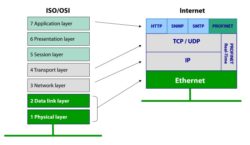What is the difference between PROFINET and Ethernet? Can you give us a PROFINET vs Ethernet comparison? We get these questions quite often. And they are kind of difficult to answer because PROFINET and Ethernet are complementing technologies, not competing technologies. This short post will illustrate the comparison between PROFINET and Ethernet.
Let’s start by looking at the ISO/OSI model, a seven-layer model that generically describes the abstraction layers of a communication system. Any network communication can be divided into a number of layers.
Ethernet Definition
IEEE 802.3 specifies the standards that makeup Ethernet. Ethernet sits on Layer 1 (physical layer) and Layer 2 (data link layer) of the ISO/OSI model. Ethernet frames include information such as the MAC addresses of sender and receiver, virtual LAN (VLAN) tagging, and Quality of Service (QoS).
Ethernet is used to connect nodes in a Local Area Network. The physical link between nodes in an Ethernet network can be, for example, a twisted pair cable, or a fiber optic cable. Nowadays, Ethernet is the most common communication medium worldwide; used in homes, enterprises, factories, and in general infrastructure due to its speed, affordability, and versatility.
PROFINET Definition
PROFINET is an Industrial Ethernet solution. It is a communication protocol to exchange data between controllers and devices. Controllers can be PLCs, DCSs, or PACs. Devices can be I/O blocks, vision systems, RFID readers, drives, process instruments, proxies, or even other controllers.
PROFINET sits on Layer 7 of the ISO/OSI model since it is an application. It defines cyclic and acyclic communication between components, including diagnostics, functional safety, alarms, and other related information. Also, PROFINET is based on standard Ethernet for its communication medium. High bandwidth, large message size, and versatility are just some of the benefits of having Ethernet on the factory floor.
PROFINET vs Ethernet
If you encounter a PROFINET network, you will notice the Ethernet cables connecting PROFINET components. If you then continue to configure the network, you will work with PROFINET controllers and devices. PROFINET allows you to build a network configuration and define the data exchange between controllers and devices in an automation network.
All in all, it is difficult to make a comparison between PROFINET and Ethernet because they are different in nature. Ethernet (Layer 1 and 2) defines the electrical signals within the wire, how to access the bus, and how to send and receive telegrams in a LAN.PROFINET is an application (Layer 7) based on Standard Ethernet for Layers 1 and 2.
Learn more about the difference between Ethernet and PROFINET with this downloadable white paper:
What Is the Difference Between PROFINET and Ethernet?
A short, yet complete PROFIBUS vs PROFINET comparison in video format:
Related Questions
Is PROFINET Ethernet?
No. PROFINET is an application that is based on Ethernet. Comparing PROFINET to Ethernet would be like comparing HTTP, OPC UA or any other application to Ethernet.
Can PROFINET networks use standard Ethernet cables?
Yes, you can employ standard Ethernet cables to build a PROFINET network. However, the Ethernet cables that you might encounter in a home or office environment might not be the best choice. Those cables can be weak and might lack shielding. The factory floor, where PROFINET is most commonly used, can be a rough environment with challenging conditions such as extreme temperatures, humidity, vibrations, and electromagnetic interference. For that reason, even though you can employ standard Ethernet cables, it is recommended to use industrial Ethernet cables. On the wire, they are the same thing. Yet, industrial Ethernet is characterized by ruggedized hardware, shielding protection, and proper jacketing.
Do I need PROFINET if I already have Ethernet in an automation network?
Yes, you still need PROFINET. You create a connection if you link two nodes in a network with an Ethernet cable. But there is so much more than just linking those two components. You will require underlying protocols to fulfill different tasks, such as sending data to the cloud, synchronizing machines, and implementing functional safety. PROFINET is critical to establishing fast and deterministic data exchange between controllers and devices.
Besides PROFINET, you can employ other Ethernet-based protocols to complement your network. But how? And which protocols? Since PROFINET is based on standard unmodified Ethernet; the network is not restricted to just PROFINET frames. For example, you can employ MQTT, SNMP, OPC UA, or HTTP to send data vertically, manage network diagnostics, or interface with web servers.
-Nelly Ayllon

